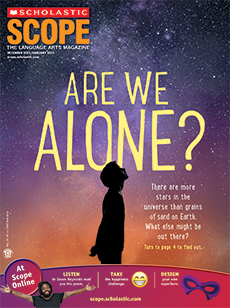1. What is the poem’s rhyme scheme, or pattern of rhymes? Use an example to support your description. This poem has an ABAB rhyme scheme; in each stanza, the first line rhymes with the third, and the second line rhymes with the fourth. For example, in stanza 1, the line “Out of the night that covers me” rhymes with the line “I thank whatever gods may be,” and the line “Black as the pit from pole to pole” rhymes with the line “For my unconquerable soul.”
2. Find two examples of alliteration, the repetition of consonant sounds at the beginning of two or more neighboring words. There is repetition of the “p” sound in “Black as the pit from pole to pole” and repetition of the “b” sound in “Under the bludgeonings of chance/My head is bloody, but unbowed.”
3. Take turns listening to your partner reading the poem aloud. What feelings do the rhymes and rhythm of the poem create for you? The poem has a musical quality. As you read, it feels like a steady and unwavering beat. This beat creates momentum that feels like moving forward, just like the speaker moves forward despite his circumstances.
4. The poem describes difficult and painful experiences the speaker endures.
a. Find an example of Henley using metaphor to describe the speaker’s hardships. In stanza 1, Henley uses metaphor to compare the speaker’s experiences to night and a black pit. This emphasizes how dark, deep, and inescapable his struggles are.
b. Find an example of Henley using personification to describe the speaker’s hardships. In stanza 2, Henley personifies “chance” and “circumstance” as forces that physically beat or strike the speaker, suggesting that events outside of his control have tried to break him.
5. Choose one of the following word pairs to describe the speaker’s tone in this poem: cheerful and amused, depressed and doubtful, defiant and determined, bitter and disappointed. What words, phrases, or lines contribute to the tone you chose? The speaker’s tone is defiant and determined. The words “bloody,” “unafraid,” and “unbowed” contribute to this tone.
6. What phrase does the speaker repeat in the final stanza? What does this repetition emphasize the importance of? The speaker repeats the phrase “I am” twice. This repetition emphasizes the importance of personal responsibility in the path your life takes. The speaker has not let his hardships define his life; he has shaped his own life through strength and determination, even when faced with seemingly impossible odds.
7. Invictus means “unconquerable” or “undefeated” in Latin. How does the title “Invictus” relate to the overall message and mood of the poem? The poem is about showing strength, defiance, and resilience in the face of hardship. It leaves the reader feeling inspired and empowered. The poem’s overall message and mood mirrors the meaning of invictus.
8. As a child, Henley (1849-1903) suffered from tuberculosis, a disease that affected his bones and required the amputation of one of his legs when he was 16. He wrote “Invictus” during an almost two-year stay in the hospital. How might the poet’s personal experiences relate to the poem’s message? Henley’s personal struggles with illness likely influenced the poem’s themes of enduring hardship and maintaining strength.



